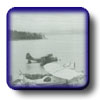Eastern Command
 In
1942, German U-boats
brought the war as close to Canadian
soil as it would get. U-553 moved into the Gulf of St. Lawrence
in May. Over the course of that summer, the U-boats would sink 21 ships in the gulf. U-boats even got close
enough to the mainland to land two German spies. Hampered
by inadequate equipment, ineffective tactical procedures
and poor command structure and inter-service communication,
Canadian Armed Forces including the Air Force were unable
to score a single U-boat kill during this period, despite
extensive efforts. Efforts to improve performance were further
impeded by the reluctance of Canada's allies to provide
it with better resources. In
1942, German U-boats
brought the war as close to Canadian
soil as it would get. U-553 moved into the Gulf of St. Lawrence
in May. Over the course of that summer, the U-boats would sink 21 ships in the gulf. U-boats even got close
enough to the mainland to land two German spies. Hampered
by inadequate equipment, ineffective tactical procedures
and poor command structure and inter-service communication,
Canadian Armed Forces including the Air Force were unable
to score a single U-boat kill during this period, despite
extensive efforts. Efforts to improve performance were further
impeded by the reluctance of Canada's allies to provide
it with better resources.
Air coverage in the St. Lawrence did at least keep shipping
losses from being even higher. Although difficult to destroy,
U-boats could effectively be kept at bay with the presence
of few or even a single armed aircraft, which would force
the U-boat into a dive. Underwater, the U-boats were slow
and often incapable of maneuvering into a position capable
to strike a shipping convoy.
While the Battle of the St. Lawrence was no doubt unnerving
to the inhabitants of the Gaspé and other areas around the
Gulf, more important was the damage the U-boats were inflicting
on shipping convoys in the Atlantic. The convoys were critical
to sustaining the Allied efforts in Europe; they were the
lifeline of Great Britain. Allied shipping losses peaked
in the winter of 1942-43, and were especially severe in
the so-called air gap in the mid-Atlantic, the space that
was left between the operational radius of Canada’s Eastern
Air Command and that of the British Coastal Command (under
which several RCAF squadrons also carried out operations).
U-boat Wolfpacks
took advantage of the gap, inflicting heavy damage to Allied
convoys.
By mid-1943, Allied commanders realized that the gap needed
to be closed. Infusing it with air and naval forces, and
with the benefit of improved radar and air/navy cooperation,
Allied forces were able to inflict heavy casualties on the
Wolfpacks, effectively dispersing them and eliminating them
as a concern.
Single U-boats continued to operate in the Atlantic up
to the Gulf of St. Lawrence throughout the war. Faced with
improved strategy and equipment on the part of Allied air
and naval forces, U-boats were rarely able to surface long
enough to maintain an effective attack against ships. The
U-boats themselves made technical advances, preventing effective
air and naval attacks against them. The result was a stand-off,
with few losses taken on either side. Escorting ships late in the war, Warrant Officer Class
One Ted Kelly got
a first hand glimpse of how new technology was used in and
over the Atlantic.
Most importantly, Allied shipping was able to continue
in support of the Allied offensive on the European mainland
beginning in June, 1944. Over the course of the war in the
Atlantic, Royal Canadian Air Force squadrons accounted for or participated in
the demise of 21 U-boats, over 10 percent of those accounted for
by Commonwealth forces overall.


|
 Heritage Community Foundation Presents
Heritage Community Foundation Presents Heritage Community Foundation Presents
Heritage Community Foundation Presents